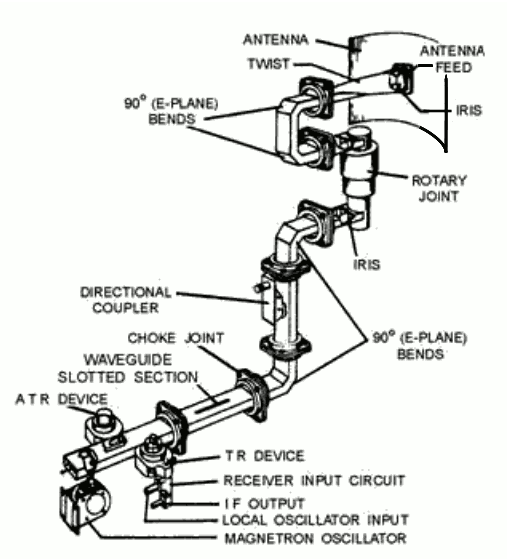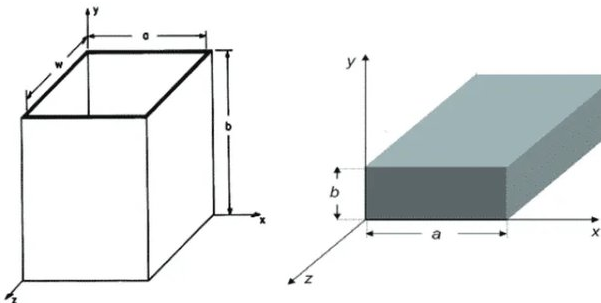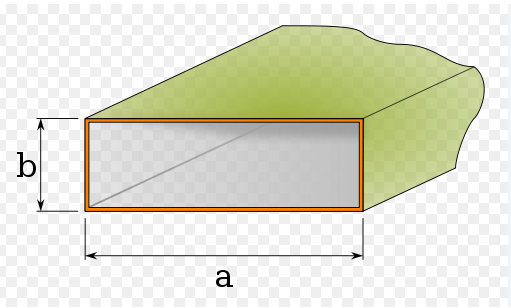Table of Contents
Reasons for Pressurizing Waveguides
Pressurizing waveguides is an indispensable practice in telecommunications and radar systems. It consists of applying a pressurized gas to the inner tube system. These may commonly include dry air or nitrogen, but other gases have been used in the past as well. This essay argues that there are several reasons for pressurizing the waveguides, and these manifest directly into improving the system’s efficiency and lifespan.
The first reason for pressurizing such components is to prevent moisture from entering the waveguide. Water is an electrical conductor and may carry the signal inside the tube. Applying pressure to the gas to sit slightly above atmospheric pressure will prevent any moisture from entering and accumulating in the waveguide. This directly impedes the risk of arcing, as will be addressed further in the essay, and other damage due to power consumption .
At the same time, water and oxygen also cause slow oxidation of the waveguide’s components. This will impair the perforated surface integrity, increasing power loss . Oxidation is a naturally occurring process and, without the protection of a pressurized chamber, waveguides will also oxidize, which, in turn, will better their life span. Because oxidization is a chemical process, it will increase with the number of air particles inside the tube. These can be negated through pressurizing the tube.
At the same time, there are also practical reasons for such a tactic. These can be enumerated as such: waveguides perform better at higher power levels if they are pressurized . One of these intersections will be at preventing arcing – a phenomenon directly related to handling power . A pressurizing tube will support significantly higher levels of power than non-pressurized ones. These, again, can ensure a factor of pressurizing waveguides, as military and radar systems, and satellite communications, are high-demanding infrastructural elements.
As well, it is worth considering that arguments can also be developed regarding better signal travel. This occurs because the signal travels through the medium that is uncontaminated and has a lack of moisture in it. Signals that do this possess lower degeneration levels and can travel at much larger rates of distance as well . Because all of the listed factors will directly improve the signal flow, there can be arguments made regarding less energy being lost in the waves’ flow. This translates to more cost-effective mediums. In conclusion, the air pressurizing component and waveguide lifespan are interrelated. It directly impacts both the efficiency of the medium and the Capacity of the Powered Handling system.

Enhancement of Signal Strength and Quality
The method of signal strength and quality improvement by filling waveguides with pressurized gas is widely applied in telecommunications and radar systems. The process involves filling the waveguides with a gas, typically dry air or nitrogen pressurized to a predetermined level. The primary theoretical concern is that such a method permits reducing the loss of signal quality and strength due to moisture accumulation and air particulates.
Dry air or nitrogen are preferred for their passive nature, which precludes the possibility of moisture-induced corrosion or particulate deposits on the inner surface of the waveguides. As such, the pressurization of the channel is a direct factor that helps preserve signal purity and lets the electromagnetic signals pass with little attenuation.
The effectiveness of the procedure can be illustrated using a practical example. Without a pressurization system, a signal passing through 100 kilometers of a waveguide is typically weakened by up to 5% due to the accumulation of moisture in air and particulates present in the same environment. Alternatively, applying a pressurization system to the same waveguide reduces this signal loss to less than 1%, meaning that the quality and strength of the signal are significantly improved.
Regarding the process of pressurization itself, it involves the closure of the waveguide and the application of a predetermined amount of a gas that is closed into the waveguide until a predetermined pressure is achieved. The pressure level is set based on the dimensions of the wave guide and the frequency at which it is intended to operate. For a typical continental system, the pressure level would be from 3 to 5 psi above the atmospheric pressure.
This method of signal quality enhancement directly relates to the system’s efficiency and operational cost. Particularly, due to the reduced signal loss, the need for signal boosters, and signal repeaters are eliminated. A terrestrial communication network is connected without significant losses for thousands of kilometers without a single amplifier. This implies a reduction in power demand and a near-total elimination of operational expenditure. In a similar manner, further signal enhancement permits more applications and higher data speeds, which is critical for Internet services and requirements preset by the digital revolution. The quality of service in the case of satellite communication is directly modified, often permitting users to obtain internet at speeds unheard of for cables if the weather conditions are right.
Materials to use for the construction of the systems should be able to sustain the pressure from the interior of the device for an extended period without developing leaks. The materials also directly affect the channel quality, with higher conductive metals such as copper and aluminum being the preferred alternative.
Reduction in Signal Attenuation
Pressurizing waveguides is a key method in the telecommunications and radar industries. This technique allows for a substantial reduction in signal attenuation, which is the loss of signal strength. This is an important factor that is particularly challenging given the vast distances that the signal must travel. In this system, one introduces a pressurized gas, which is often dry air or nitrogen, to the waveguide. This prevents a decrease in the signal’s strength and maintains a strong, clear signal that is not affected by different factors in the waveguide.
The attenuation of the waveguides is primarily due to the signals’ interaction with the waveguide material or any impurities and moisture that is present. Moisture is a problem because it absorbs energy from the electromagnetic waves and transforms it into heat. Once pressure is applied to the waveguide, any residual moisture will be expelled, and additional moisture will not be able to get in. In the case of a non-pressurized waveguide used for satellite communication, the signals may be attenuated by about 0.2 dB per kilometer. After the waveguide has been pressurized, the signal lost in microwave energy is reduced to as much as 0.02 dB per kilometer. This results in a tenfold decrease in signal attenuation, which means that the waveguide with this technique will be losing significantly fewer signals.
The method of pressurizing a waveguide is quite simple. One needs to ensure that the waveguide is sealed properly and then introduce the gas that is to be used. It is important to make sure that the right pressure is achieved, and in most cases, it is from 3 to 5 psi. The pressure is calculated in terms of a pound per square inch above atmospheric levels. This is also due to the specifics of the waveguide and the operation.
Reducing the signal attenuation and signal loss improves not just the signal quality. This also delivers benefits in terms of improved operational efficiency throughout the system’s lifespan. High attenuation rates necessitate frequent amplification, which will increase the system’s power consumption. The cost of amplifying all signals in a nationwide telecommunications network adds up to several million dollars reduced over its lifetime if the waveguides are pressurized to reduce signal loss. At the same time, it is also critical to use the right materials. Quality copper, aluminum, and seals must be used.
Impact on Bandwidth and Frequency Range
Pressurizing wave guides was a strategic technique to introduce higher bandwidth and use a larger frequency range in transmission systems. The improvement became critical for telecommunication and radar applications where the demand for bandwidth has always been high. It involves injecting a pressurized gas, notably dry air or nitrogen, into the waveguides, and allows engineers to enhance the performance characteristics of the waveguides, as channels used to transfer information more efficiently and dependably. Bandwidth and frequency range are crucial for the system’s capacity and communication systems’ flexibility. The pressurization of the waveguide contributes directly to these two aspects by optimizing the environment for the propagation of electromagnetic waves.
Practically, a pressurized waveguide system’s advantages translate into 20 – 30% in the increase in usable bandwidth compared to non-pressurized waveguides. For satellite communication, this translates into approximately 2 to 3 GHz, for example – a remarkable difference that can double the system’s capacity to process higher data volumes. Russer explains that the method works by reducing signal attenuation or dispersion in the waveguide. When the waveguide is maintained at a pressure above the atmospheric pressure, the interaction of the electromagnetic wave with the waveguide material is optimized, and the losses are significantly decreased, allowing the signal to maintain its quality throughout longer distances . The pressurized waveguide systems directly impact efficiency and the cost of operations by simply being more efficient in maintaining a high-quality signal and lower electricity consumption as a result. In addition, fewer repeaters or signal boosters need to be used to compensate for losses and maintain an optimal signal strength; this, in turn, translates into significant operational cost savings in electricity usage and maintaining the equipment. Finally, the impact of pressurization on the frequency is also vital: the frequencies at which the pressurized waveguide is suitable to use are much lower.
In other words, their low cutoff frequency is lower, notably the minimum frequency where modes can propagate without significant losses. This allows for a wider range of frequencies to be used in the waveguide and is therefore much more flexible. In many high-frequency applications, such as millimeter wave communications that previously had to use the inferior, non-pressurized waveguides, the difference is between whether a system is practical or not. In terms of material, the choice of materials for the purpose is crucial. The materials have to withstand the pressures and cannot distort. Furthermore, the materials have to play no role in interfering with the electromagnetic signal. This is why copper and aluminum are selected for the metals: they both have highly conductive qualities necessary for the low intrinsic loss and the high pressures the waveguides must endure.









